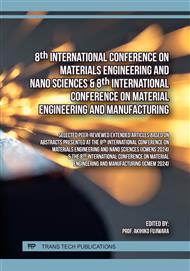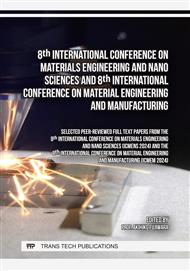p.3
p.13
p.19
p.25
p.31
p.37
p.45
p.53
Chemical Constituents of Black Galingale Rhizome from Hexane Crude Extract and its Nanoemulsion Preparation
Abstract:
Kaempferia parviflora (Black Galingale) is a medicinal plant in the family Zingiberaceae. It has biological activities, but the bioactive compounds are easily decomposed and poorly soluble. This research has focused on the chemical constituents and bioactivities of the hexane crude extract from K. parviflora rhizomes for nanotechnology. The K. parviflora rhizomes were extracted with hexane by the maceration. The crude extract 39.99 g was obtained and purified using column chromatography to give four pure compounds, namely (1) 5-hydroxy-3,7-dimethoxyflavone, (2) 5-hydroxy-7-methoxyflavone, (3) 3,5,7-trimethoxyflavone, and (4) 5,7-dimethoxyflavone. Spectroscopic techniques confirmed the identities of these isolated compounds. Furthermore, compound (1) showed the best antioxidant activities by DPPH assay with an inhibition value of 64.88% compared to standard Trolox with a value of 244.16 ± 4.03 mM, Furthermore, it demonstrated impressive growth of S. aureus and P. aeroginosa. These promising properties suggest its potential for formulation development. 5-hydroxy-3,7-dimethoxyflavone o/w nanoemulsion displayed a transparent apparent yellow color, high stability nanoparticles size of 24.8 nm, and a zeta-potential of -53.2 mV, even after exceeding 3 mounts of storage. The results showed the potential of K. parviflora rhizome extract for nanotechnology applications and its promising future in health and beauty product development for industrial biotechnology processes.
Info:
Periodical:
Pages:
25-30
Citation:
Online since:
September 2024
Keywords:
Price:
Сopyright:
© 2024 Trans Tech Publications Ltd. All Rights Reserved
Share:
Citation:



